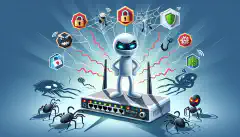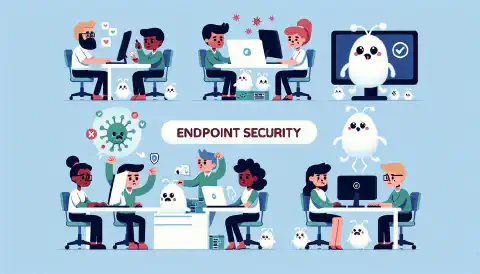Fortify Your Home Network: 10 Vital Cybersecurity Checks for Total Digital Defense

Table of Contents
10 Essential Cybersecurity Checks for Your Home Network
In today’s digital age, home network security is more important than ever. With the increasing number of devices connected to our home networks, it is crucial to ensure that our personal information is protected and unauthorized access is prevented. This article will provide you with 10 essential cybersecurity checks for your home network to help you safeguard your data and maintain a secure online environment.
Key Takeaways
- Understanding the risks associated with home network security
- Protecting personal information by implementing strong security measures
- Changing default router settings and creating a strong Wi-Fi password
- Enabling network encryption to secure your Wi-Fi network
- Keeping operating systems, firmware, and software up to date
Importance of Home Network Security
Understanding the Risks
As a cybersecurity expert, it is crucial to understand the risks associated with home network security. Cyber threats are constantly evolving, and without proper protection, your personal information and sensitive data are at risk. It is important to be aware of the potential consequences of a compromised home network, such as identity theft, financial loss, and privacy breaches.
To help you better understand the risks, here are some key points to consider:
Malware: Malicious software, such as viruses, worms, and ransomware, can infiltrate your home network and cause significant damage. It is essential to have robust antivirus software in place to detect and remove any malware.
Phishing Attacks: Cybercriminals often use phishing emails and websites to trick individuals into revealing sensitive information. Being able to identify and avoid phishing attempts is crucial in protecting your personal data.
Weak Passwords: Using weak or easily guessable passwords can make it easier for hackers to gain unauthorized access to your home network. It is important to create strong, unique passwords for all your devices and accounts.
Tip: Regularly update your passwords and consider using a password manager to securely store and manage them.
- Unsecured IoT Devices: Internet of Things (IoT) devices, such as smart thermostats and security cameras, can be vulnerable to attacks if not properly secured. Make sure to change default passwords, update firmware regularly, and isolate IoT devices from your main network.
By understanding these risks and taking appropriate measures to mitigate them, you can significantly enhance the security of your home network.
Protecting Personal Information
Protecting personal information is crucial in maintaining the security of your home network. By implementing the following measures, you can significantly reduce the risk of unauthorized access and data breaches:
- Use strong and unique passwords for all your online accounts and devices. Avoid using common passwords or easily guessable information such as your name or birthdate.
- Enable two-factor authentication whenever possible. This adds an extra layer of security by requiring a second form of verification, such as a code sent to your mobile device.
- Encrypt sensitive data to ensure that even if it is intercepted, it cannot be read by unauthorized individuals.
- Regularly update and patch your software and applications. This helps to address any vulnerabilities that may be exploited by hackers.
- Be cautious when sharing personal information online. Avoid providing unnecessary personal details on social media platforms or unsecured websites.
Remember, protecting your personal information is essential for safeguarding your privacy and preventing identity theft.
Preventing Unauthorized Access
Preventing unauthorized access is a crucial aspect of home network security. By implementing strong authentication measures and following best practices, you can significantly reduce the risk of unauthorized individuals gaining access to your network. Here are some key steps to prevent unauthorized access:
Securing Your Wi-Fi Network

Changing Default Router Settings
When it comes to securing your home network, one of the first steps you should take is changing the default settings on your router. Default settings are often well-known and can make your network vulnerable to attacks. By changing these settings, you can significantly enhance the security of your network.
Here are some important points to consider when changing default router settings:
- Disable Remote Management: Remote management allows you to access your router’s settings from outside your home network. However, it also provides an entry point for attackers. Disable this feature to prevent unauthorized access.
- Change the Default Administrator Password: The default password for your router’s administrator account is usually easy to guess. Change it to a strong, unique password to protect against unauthorized access.
- Enable MAC Address Filtering: MAC address filtering allows you to specify which devices can connect to your network based on their unique MAC addresses. This adds an extra layer of security by preventing unauthorized devices from accessing your network.
By following these steps and changing the default router settings, you can significantly improve the security of your home network.
Creating a Strong Wi-Fi Password
Creating a strong Wi-Fi password is crucial for protecting your home network from unauthorized access. A weak password can make it easier for hackers to gain access to your network and compromise your personal information. To ensure the security of your Wi-Fi network, follow these guidelines :
Enabling Network Encryption
Enabling network encryption is a crucial step in securing your home network. By encrypting your network traffic, you can protect your sensitive information from being intercepted by unauthorized individuals. Network encryption uses cryptographic algorithms to scramble data , making it unreadable to anyone without the encryption key. This ensures that even if someone manages to access your network, they won’t be able to decipher the data transmitted over it.
Updating and Patching Devices

Keeping Operating Systems Up to Date
To ensure the security of your home network, it is crucial to keep all operating systems up to date. Regular updates provide essential patches and fixes that address vulnerabilities and strengthen the overall security of your devices. By keeping your operating systems updated, you can minimize the risk of cyberattacks and protect your personal information from unauthorized access.
Updating Firmware and Software
Updating firmware and software is crucial for maintaining the security of your home network. By regularly updating these components, you can ensure that any vulnerabilities or weaknesses are patched , reducing the risk of unauthorized access or data breaches. Firmware updates often include security enhancements and bug fixes, so it is important to stay up to date with the latest versions. Similarly, software updates may include important security patches that address known vulnerabilities. By keeping your firmware and software updated, you can strengthen the overall security of your home network.
Installing Security Patches
Installing security patches is a crucial step in maintaining the security of your home network. By regularly updating your devices with the latest patches, you can protect against known vulnerabilities and reduce the risk of unauthorized access . It is important to stay vigilant and ensure that all devices connected to your network, including routers, computers, and IoT devices, are kept up to date with the latest security patches.
Implementing Firewalls and Antivirus Software

Setting Up a Firewall
Setting up a firewall is an essential step in securing your home network. A firewall acts as a barrier between your network and the internet, monitoring and controlling incoming and outgoing network traffic. By setting up a firewall, you can protect your network from unauthorized access and potential cyber threats. Here are some key points to consider when setting up a firewall:
Choosing and Installing Antivirus Software
When it comes to choosing and installing antivirus software, there are several important factors to consider. Network anomalies detection is one such factor that should not be overlooked. By implementing antivirus software that includes network anomalies detection, you can enhance the security of your home network. This feature allows the software to monitor network traffic and identify any unusual or suspicious behavior . By detecting and alerting you to potential threats, network anomalies detection can help prevent unauthorized access and protect your personal information.
Regularly Scanning for Malware
Regularly scanning for malware is an essential practice to ensure the security of your home network. By conducting regular scans, you can detect and remove any malicious software that may have infiltrated your devices or network. Malware refers to any software designed to harm or exploit your devices, steal sensitive information, or gain unauthorized access.
To effectively scan for malware, consider the following:
- Use reputable antivirus software that is regularly updated to detect the latest threats.
- Schedule automated scans to run at regular intervals, such as daily or weekly.
- Perform manual scans whenever you suspect a potential threat or after downloading files from untrusted sources.
By regularly scanning for malware, you can identify and eliminate any potential security risks, protecting your home network and personal information from unauthorized access and data breaches.
Tip: Keep your antivirus software up to date and ensure it includes real-time scanning for continuous protection against emerging threats.
Securing IoT Devices

Changing Default Passwords
Changing the default passwords is a crucial step in securing your IoT devices. Default passwords are often well-known and easily accessible to hackers, making it easier for them to gain unauthorized access to your devices. By changing the default passwords, you can significantly reduce the risk of unauthorized access and protect your devices from potential attacks.
Updating Firmware
Updating firmware is a crucial step in maintaining the security of your devices. Firmware updates often include important security patches that address vulnerabilities and improve cybersecurity . By regularly updating the firmware on your devices, you can ensure that they have the latest security enhancements and protection against emerging threats.
Isolating IoT Devices
Isolating IoT devices is a crucial step in ensuring the security of your home network. By separating these devices from the rest of your network, you can minimize the potential attack surface and reduce the risk of unauthorized access.
Benefits of Isolating IoT Devices
- Enhanced security: Isolating IoT devices helps prevent them from being compromised and used as entry points into your network.
- Privacy protection: By isolating IoT devices, you can limit their ability to collect and share sensitive personal information.
- Network performance optimization: Separating IoT devices can help prevent them from consuming excessive bandwidth and affecting the performance of other devices on your network.
How to Isolate IoT Devices
There are several methods you can use to isolate IoT devices:
- Create a separate network: Set up a dedicated network specifically for your IoT devices. This can be done by creating a separate Wi-Fi network or using a VLAN (Virtual Local Area Network).
- Use guest network functionality: Many routers offer a guest network feature, which allows you to create a separate network for visitors and IoT devices.
- Implement network segmentation: Divide your network into different segments or subnets, with each segment dedicated to specific types of devices.
Tip: When isolating IoT devices, it’s important to regularly update their firmware to ensure they have the latest security patches and bug fixes.
By following these steps, you can significantly enhance the security of your home network and protect your IoT devices from potential threats.
Securing IoT devices is crucial in today’s interconnected world. With the rapid growth of the Internet of Things (IoT), more and more devices are being connected to the internet, making them vulnerable to cyber attacks. At simeononsecurity, we understand the importance of protecting your IoT devices from potential threats. Our experts provide the latest trends and best practices in cybersecurity , automation, and crypto. Whether you’re a business owner or a tech enthusiast, our website is your essential resource for all things related to privacy, security, and technology. Stay ahead in cybersecurity and visit simeononsecurity.com today!
Conclusion
In conclusion, ensuring the security of your home network is of utmost importance in today’s digital age. By following the 10 essential cybersecurity checks outlined in this article, you can significantly reduce the risk of cyber threats and protect your personal information. Understanding the risks associated with home network security is the first step towards implementing effective measures. Protecting personal information and preventing unauthorized access should be top priorities for every homeowner. Securing your Wi-Fi network by changing default router settings, creating a strong Wi-Fi password, and enabling network encryption adds an extra layer of protection. Regularly updating and patching devices is crucial to address any vulnerabilities and ensure optimal security. Implementing firewalls and antivirus software provides additional defense against malicious activities. Lastly, securing IoT devices by changing default passwords, updating firmware, and isolating them from the main network is essential. By following these steps, you can create a secure home network environment. Stay vigilant and prioritize cybersecurity to safeguard your digital assets and maintain peace of mind.
Frequently Asked Questions
What is the importance of home network security?
Home network security is important to protect personal information, prevent unauthorized access, and understand the risks associated with cyber threats.
How can I protect my personal information on my home network?
You can protect your personal information on your home network by using strong passwords, enabling network encryption, and being cautious about sharing sensitive information online.
What are some ways to prevent unauthorized access to my home network?
To prevent unauthorized access to your home network, you can change default router settings, disable remote management, and regularly update firmware and software.
Why is it important to change default router settings?
Changing default router settings is important to prevent hackers from easily accessing your network, as they often know the default settings of popular router models.
How can I create a strong Wi-Fi password?
To create a strong Wi-Fi password, use a combination of uppercase and lowercase letters, numbers, and special characters. Avoid using easily guessable information, such as your name or address.
What is network encryption and why is it important?
Network encryption is the process of encoding information sent over a network to protect it from unauthorized access. It is important because it ensures that data transmitted between devices on your network is secure and cannot be intercepted by hackers.






